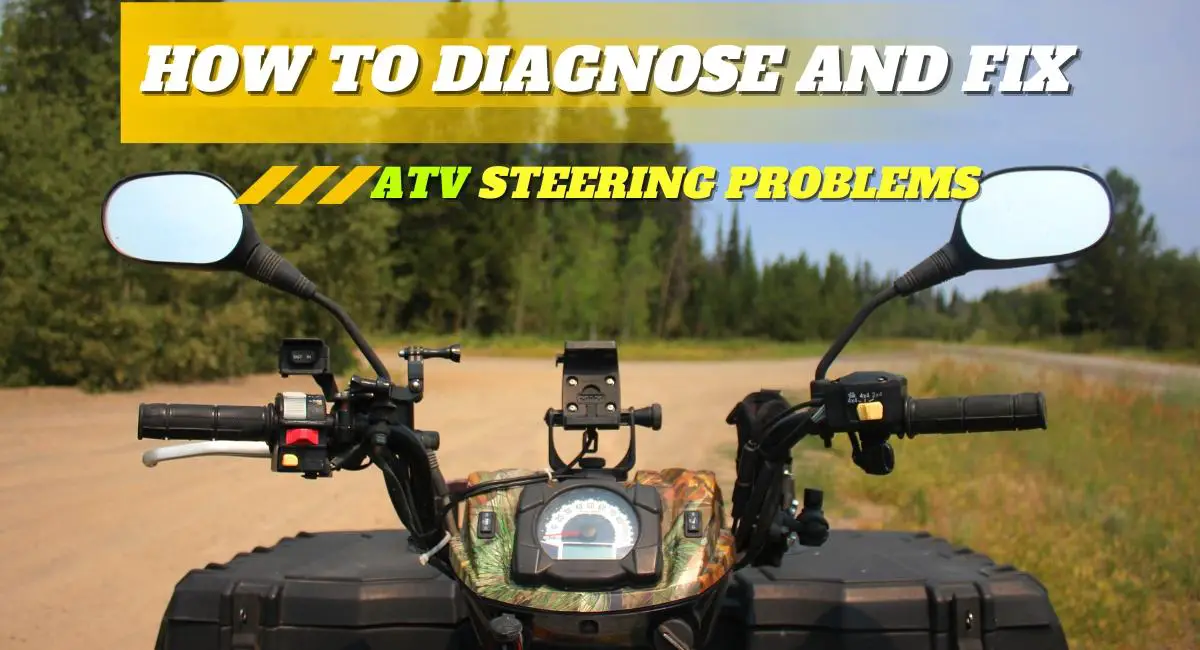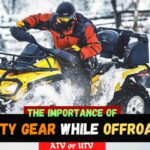A responsive steering system is key for a fun ATV ride, especially when you’re navigating tight corners on tough trails. If your ATV is experiencing steering problems or is hard to steer, it not only takes away the fun but also makes it a bit risky.
ATV steering problems are especially pronounced when the power steering becomes stiff. This, in turn, makes it tough to quickly handle changes on the trail. As such, learning how to diagnose and fix ATV steering problems is crucial in ensuring safer and more enjoyable off-roading.
How to Diagnose ATV Steering Problems
ATVs may encounter steering issues occasionally, but if the steering feels significantly stiffer than usual, it could indicate a more serious problem. When your ATV starts to feel hard to steer or inflexible, it may exhibit several symptoms, such as;

Uneven Steering
One of the most common signs of steering problems in an ATV is uneven steering. This is often characterized by the ATV pulling to one side, which can impact both the stability and overall handling of the vehicle.
This issue often arises due to misalignment, where the front wheels lack proper adjustment, causing the ATV to deviate from its intended course. Moreover, inadequate tire maintenance, such as improper pressure or neglecting tread conditions, can also contribute to uneven steering.
Hard Steering
Hard steering in an ATV is characterized by the rider experiencing difficulty turning the handlebars, coupled with an overall increase in resistance. If left unsolved, hard steering can significantly impact the rider’s control and maneuverability.
The most common culprit of hard steering is low tire pressure or uneven tire wear. If the ATV is constantly exposed to challenging terrain or the tires are not maintained regularly, it can lead to underinflated tires, resulting in increased resistance during steering.
Another potential cause of difficult steering is a fault within the power steering system. Power steering issues can often contribute to a stiff feel in the handlebars, making it challenging for the rider to navigate smoothly.
Loose Steering
Loose steering in an ATV manifests through a notable excess of play in the handlebars and a lack of responsiveness. Ideally, loose steering often undermines the rider’s control, plus it can be a safety hazard for other riders.
Loose or worn steering components, such as tie rods and ball joints, are the primary culprits for loose steering. In addition, extended use may result in these components developing play over time, thereby making the steering loose.
Misalignment of the steering system is another factor that can lead to loose steering. If the steering system is not aligned properly, it can impart an unresponsive feel to the handlebars, which might interfere with overall handling.
Unusual Noises
Unusual noises during steering, such as clicking, popping, or grinding sounds, can be a sign of underlying issues with the ATV steering system. These sounds are more than just an annoyance and in most cases, they often point to serious problems that demand immediate action.
One common cause of these noises is wear or damage to critical steering components like CV joints, tie rods, or ball joints. Insufficient lubrication in these components can also contribute to unusual noises during steering.
Jerky Movements
Jerky movements in an ATV can be identified by the steering failing to move smoothly and exhibiting erratic behavior. The ATV may also feel less responsive, especially when navigating corners or making quick turns.
Wear or damage of steering components is often the primary cause of erratic ATV movements. Inconsistent tire pressure can also result in uneven contact with the terrain, causing the ATV steering to respond unpredictably.
Steering Wheel Vibrations
Steering wheel vibrations or wobbling is often a clear indication of steering issues. The steering wheel may exhibit noticeable shaking or pulsation, particularly during turns. However, excess vibrations could indicate problems not only with the power steering but also with other aspects of your vehicle, including unbalanced wheels, worn brake pads, faulty brake calipers, and engine-related issues.
How to Fix ATV Steering Problems
I. Inspect Steering Components for Bends or Damage
The first step you’ll need to take to fix steering issues in an ATV is to inspect its steering components for any signs of bends or damage. During this inspection, you may want to thoroughly examine components such as the tie rods, steering arms, and any connecting rods for signs of bending or damage.
If you identify any compromise to the structural integrity of these steering components, it is essential to fix them as soon as possible. Failure to do so can magnify steering issues, leading to imprecise steering, reduced control, and safety hazards.
II. Check Tire Pressure
Proper tire pressure is crucial for fixing and preventing ATV steering problems. As such, adequate inflation helps ensure precise handling and maximum traction, as well as preventing damage to tires and steering components.
You can utilize an appropriate tire pressure gauge to provide an accurate measurement of the air pressure within each tire. This will help you identify and rectify any deviations from the recommended pressure levels.
III. Ensure Proper Lubrication
Regularly lubricate all moving parts in the steering system to minimize friction and optimize performance. Lubrication will help ensure that components, such as ball joints and pivot points, operate smoothly, thereby reducing wear and extending lifespan. Proper lubrication also contributes to a quieter and more responsive steering experience.
IV. Balance the Wheels
Imbalanced wheels are often a source of vibrations, which cause issues such as uneven steering and reduced stability. Additionally, when the wheels are not balanced, it can create additional stress on the steering system, thereby affecting its performance and responsiveness. As such, balancing the wheels will help optimize weight distribution and reduce vibrations, resulting in a smoother and more stable ride.
V. Routine fluid level check
Adequate power steering fluid is essential for the smooth operation of the power steering pump and other components. Insufficient fluid can result in increased friction, leading to issues such as stiffness or difficulty turning the steering wheel.
As part of regular maintenance checks, ensure to conduct regular checks of the power steering fluid levels. This will help ensure that an adequate amount of hydraulic fluid is available, thereby maintaining the necessary pressure for smooth and responsive steering.
VI. Inspect Bearings for Wear
Bearings are crucial for the smooth operation of the engine as well as the steering system. As such, you may want to make sure that the bearings are in tip-top shape to ensure they function optimally, as well as maintain steering precision and responsiveness.
VII. Tightening Nuts and Bolts
As we mentioned, excess vibrations can contribute to the gradual loosening of nuts and bolts in the steering system. This can, in turn, compromise the structural integrity of the steering system, leading to unpredictable steering behavior. Tightening loose nuts and bolts can help keep most of these issues at bay while ensuring that components remain securely fastened. Additionally, it contributes to the overall safety and reliability of your ATV.
Conclusion
Steering through tight corners demands an ATV that doesn’t require you to exert your entire body weight. Unfortunately, your ATV can be hard to steer, especially when you least expect it. If steering becomes excessively difficult, you’ll need to get to the root of the problem to enhance the enjoyment of your riding experience. Remember, steering problems make the ATV less responsive, making the rides far more dangerous.




